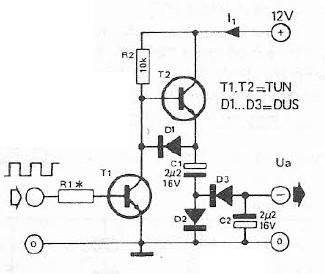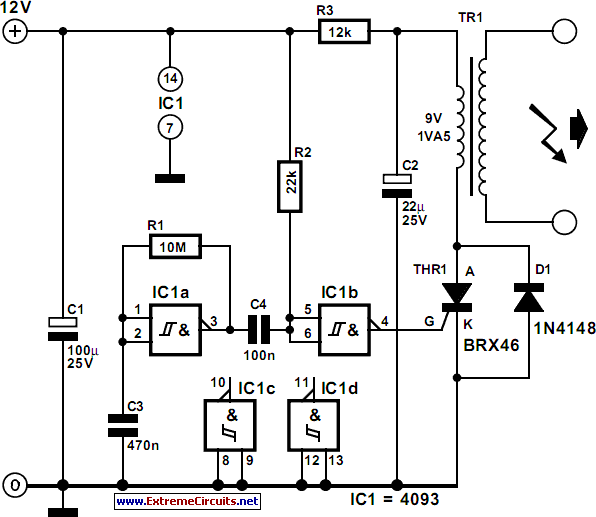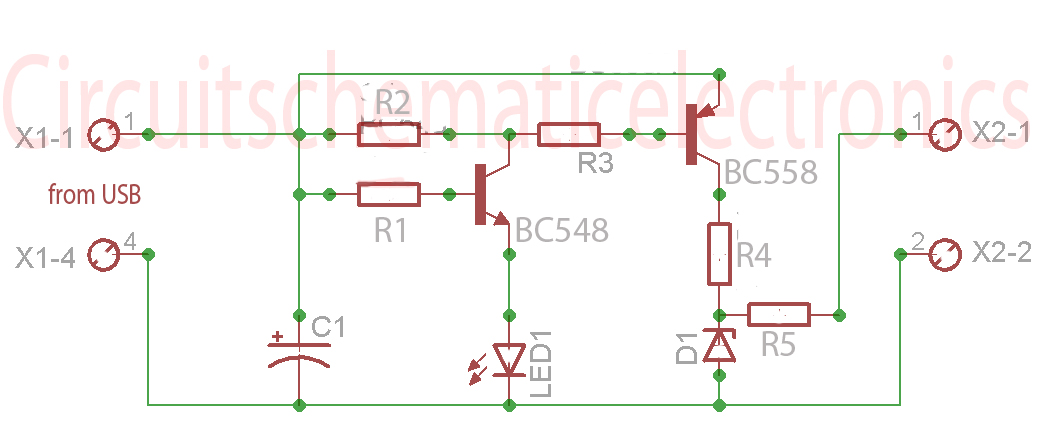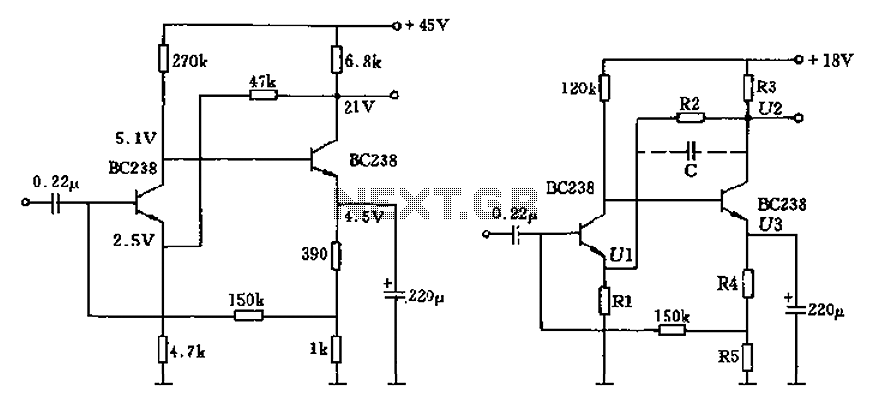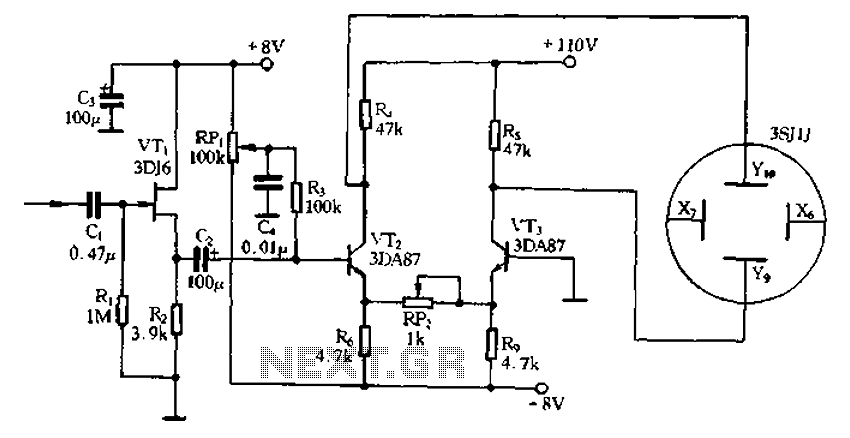
very simple VCA circuit
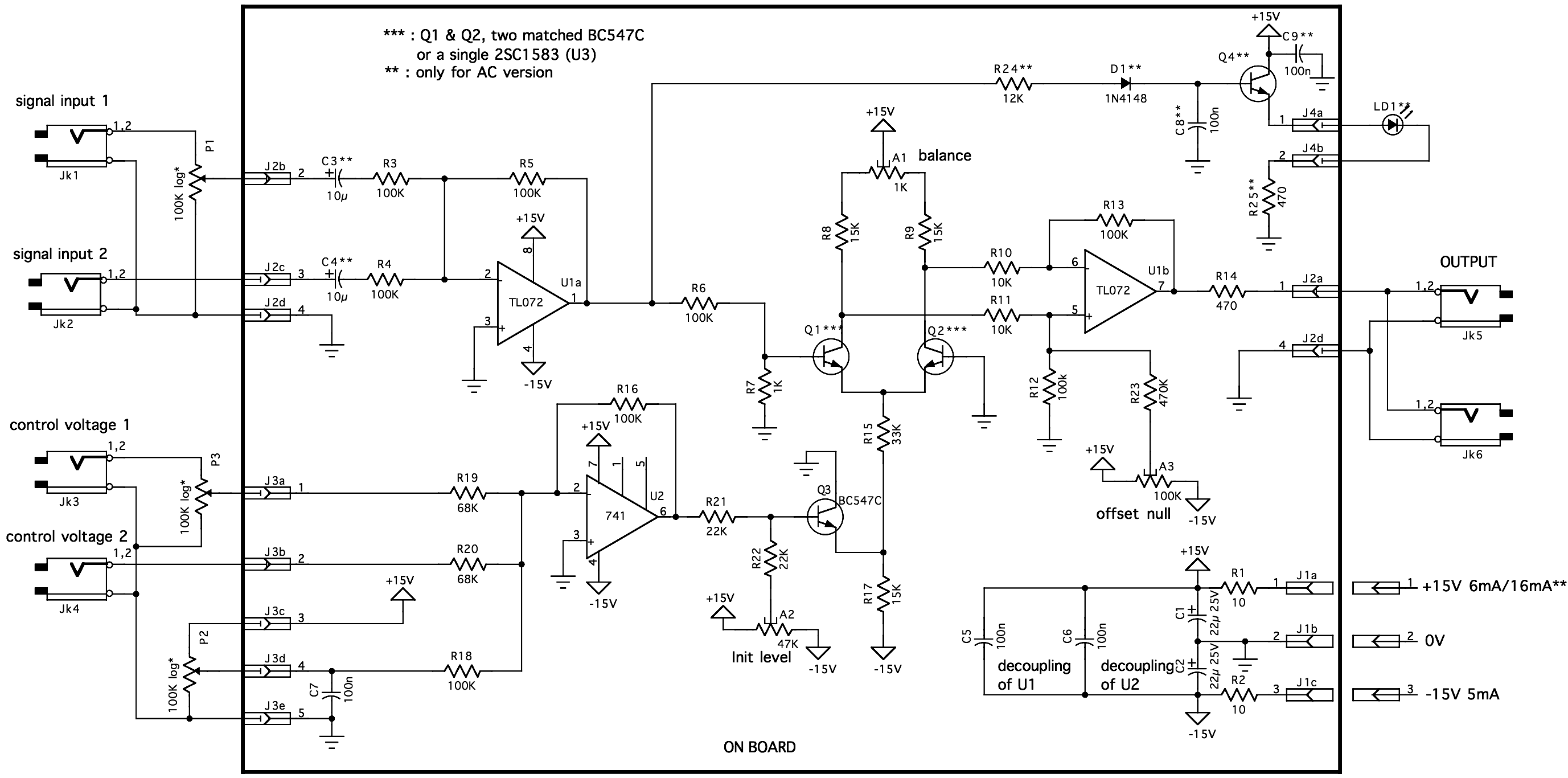
Trimming is straightforward when matched NPN transistors are utilized for Q1 and Q2, along with 1% tolerance resistors for R6 to R11. A dual trace oscilloscope, digital voltmeter (DVM), and sine wave generator are required for this process. Although 10-turn trimmers are more costly than 1-turn trimmers, they facilitate high-accuracy adjustments. The trimmer A1 should be adjusted to achieve a perfectly symmetrical sine wave at the output; the optimal method involves overlaying the input sine wave trace with the output sine wave trace. Additionally, slight adjustments to A2 may be necessary to reduce gain if saturation occurs on both the positive and negative peaks of the output sine wave. When A3 is in use, it must be calibrated as follows: after completing the previous adjustments, turn P1, P2, and P3 fully counter-clockwise (indicating no signal and no control voltage) and adjust A3 to achieve an output level at pin 7 of U1b as close to 0V as possible. If needed, repeat the adjustments from steps 2 to 7. If a unit gain for maximum control voltage is insufficient, increasing the values of R10 and R11 (for instance, setting R10 and R11 to 47kΩ will double the output gain) may be beneficial. With the specified component values, the voltage-controlled amplifier (VCA) remains perfectly linear for input signals not exceeding 10V peak-to-peak. Beyond this threshold, the VCA becomes progressively overdriven, resulting in distortion. Troubleshooting this distortion is not recommended, as overdriving a VCA can enhance its sound characteristics. For certain signals, such as sawtooth and square waves, high-frequency resonance may occur at very steep edges; this can be mitigated by soldering a small ceramic capacitor (between 7pF and 10pF) in parallel with R11.
The circuit described involves the use of matched NPN transistors for optimal performance in a voltage-controlled amplifier (VCA) configuration. The importance of using 1% tolerance resistors for R6 to R11 is emphasized, as these components contribute to the precision of the circuit’s operation. The dual trace oscilloscope and DVM are essential tools for visualizing and measuring the output waveforms, allowing for accurate adjustments to be made.
The use of 10-turn trimmers is recommended for their ability to provide fine-tuning capabilities, which is crucial for achieving the desired output characteristics. The adjustment of trimmer A1 is critical for ensuring that the output sine wave is symmetrical. Overlaying the input and output traces on the oscilloscope provides a visual reference, making it easier to achieve the desired symmetry.
The adjustment of A2 is also mentioned, which plays a role in controlling the gain of the VCA. If saturation occurs, it is necessary to reduce the gain to ensure a clean output signal. The calibration of A3 is detailed, with specific steps outlined to achieve a target output level at pin 7 of U1b. The process of adjusting P1, P2, and P3 to their minimum positions before calibrating A3 is crucial for establishing a baseline for further adjustments.
The potential for increasing the gain by adjusting resistor values R10 and R11 is noted, providing flexibility in the circuit design to accommodate different operational needs. The linearity of the VCA for input signals up to 10Vpp is highlighted, along with the warning regarding distortion at higher levels. The decision not to troubleshoot distortion is based on the creative potential of overdriving the VCA, suggesting an understanding of the artistic applications of such a circuit.
Finally, the mention of high-frequency resonance in certain waveforms indicates the importance of addressing potential issues in signal integrity. The recommendation to add a small ceramic capacitor in parallel with R11 serves as a practical solution for mitigating undesirable resonances, ensuring a cleaner output for various waveform types. This comprehensive approach to circuit trimming and calibration emphasizes the importance of precision and adaptability in electronic design.Trimming is quite easy if you use matched NPNs for Q1 and Q2, and 1% tolerance resistors for R6 to R11. You will need a dual trace scope, a DVM and a sinewave generator. Using 10 turn trimmers is a little bit more expensive than using 1 turn but makes it easier to adjust with high accuracy.
Adjust the trimmer A1 in order to have a perfectly symmetrical sine wave at the output (the best way is to superimpose the trace of the sinewave at input and the one at the output). You may have also to play slightly with A2 as well to reduce gain if you have saturation on both the positive and negative crests of the output sinewave.
When used, A3 must be adjusted as follows : after completion of the previous settings, turn P1, P2 and P3 fully counter-clockwise (no signal, no CV) adjust A3 in order to have an output level (pin 7 -U1b) as close as possible to 0V. If necessary, repeat the settings from 2 to 7. If you find that a unit gain for maximum control voltage is not enough for you may increase the values of R10 and R11 (e.
g. setting R10 & R11 to 47K will double the output gain). With the component values that are used, the VCA is perfectly linear for input signals that do not exceed 10Vpp. Above this level the VCA gets progressively overdriven and starts distorting. I choose not to troubleshoot this since overdriving a VCA can add some byte to its sound ! On some signals (saw, square) there may be some high frequency resonance on very steep edges, this may be eliminated by soldering a small 7pF to 10pF ceramic capacitor in parallel with R11.
🔗 External reference
The circuit described involves the use of matched NPN transistors for optimal performance in a voltage-controlled amplifier (VCA) configuration. The importance of using 1% tolerance resistors for R6 to R11 is emphasized, as these components contribute to the precision of the circuit’s operation. The dual trace oscilloscope and DVM are essential tools for visualizing and measuring the output waveforms, allowing for accurate adjustments to be made.
The use of 10-turn trimmers is recommended for their ability to provide fine-tuning capabilities, which is crucial for achieving the desired output characteristics. The adjustment of trimmer A1 is critical for ensuring that the output sine wave is symmetrical. Overlaying the input and output traces on the oscilloscope provides a visual reference, making it easier to achieve the desired symmetry.
The adjustment of A2 is also mentioned, which plays a role in controlling the gain of the VCA. If saturation occurs, it is necessary to reduce the gain to ensure a clean output signal. The calibration of A3 is detailed, with specific steps outlined to achieve a target output level at pin 7 of U1b. The process of adjusting P1, P2, and P3 to their minimum positions before calibrating A3 is crucial for establishing a baseline for further adjustments.
The potential for increasing the gain by adjusting resistor values R10 and R11 is noted, providing flexibility in the circuit design to accommodate different operational needs. The linearity of the VCA for input signals up to 10Vpp is highlighted, along with the warning regarding distortion at higher levels. The decision not to troubleshoot distortion is based on the creative potential of overdriving the VCA, suggesting an understanding of the artistic applications of such a circuit.
Finally, the mention of high-frequency resonance in certain waveforms indicates the importance of addressing potential issues in signal integrity. The recommendation to add a small ceramic capacitor in parallel with R11 serves as a practical solution for mitigating undesirable resonances, ensuring a cleaner output for various waveform types. This comprehensive approach to circuit trimming and calibration emphasizes the importance of precision and adaptability in electronic design.Trimming is quite easy if you use matched NPNs for Q1 and Q2, and 1% tolerance resistors for R6 to R11. You will need a dual trace scope, a DVM and a sinewave generator. Using 10 turn trimmers is a little bit more expensive than using 1 turn but makes it easier to adjust with high accuracy.
Adjust the trimmer A1 in order to have a perfectly symmetrical sine wave at the output (the best way is to superimpose the trace of the sinewave at input and the one at the output). You may have also to play slightly with A2 as well to reduce gain if you have saturation on both the positive and negative crests of the output sinewave.
When used, A3 must be adjusted as follows : after completion of the previous settings, turn P1, P2 and P3 fully counter-clockwise (no signal, no CV) adjust A3 in order to have an output level (pin 7 -U1b) as close as possible to 0V. If necessary, repeat the settings from 2 to 7. If you find that a unit gain for maximum control voltage is not enough for you may increase the values of R10 and R11 (e.
g. setting R10 & R11 to 47K will double the output gain). With the component values that are used, the VCA is perfectly linear for input signals that do not exceed 10Vpp. Above this level the VCA gets progressively overdriven and starts distorting. I choose not to troubleshoot this since overdriving a VCA can add some byte to its sound ! On some signals (saw, square) there may be some high frequency resonance on very steep edges, this may be eliminated by soldering a small 7pF to 10pF ceramic capacitor in parallel with R11.
🔗 External reference
